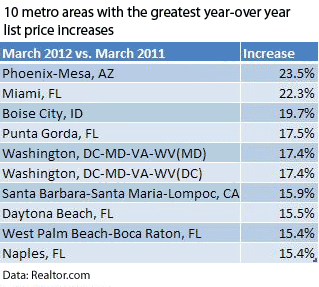Could it be that housing has emerged from its funk?
While some hard-hit markets still lag, overall, a number of key indicators are pointing in that direction and could confirm “the beginning of a broad-based housing recovery,” according to the latest report from Realtor.com. “We’re seeing some hope,” says Steve Berkowitz, the company’s chief executive officer, adding that in general, close-in suburbs are recovering faster than the outlying ones. The report looked at data from March 2012 and compared it with a year earlier.
Signaling the more optimistic outlook, median list prices for resale homes jumped about 5.6% to $189,900 from a year before. (Sales prices of existing homes eased up 0.3% in February to an estimated $156,600 from a year earlier, according to the latest statistics from the National Association of Realtors.)
 |
In the 146 markets Realtor.com surveyed, listing prices were up 1% year over year in 111 metropolitan statistical areas and 5% or more in 70 cities. The biggest listing price increases happened in two places that had been hard-hit by the foreclosure crisis, Phoenix and Miami. The report suggests that because asking prices have risen, these two cities, as well as Boise City, Idaho, and Punta Gorda, Fla., “appear to be in the recovery process.”
Listing prices were flat in 18 markets and fell more than 1% in 17 markets. Only two cities, Chicago and Knoxville, Tenn., experienced a drop of 5% or more. The report says that the shift shows a change in the nation’s housing problems “away from the sand states and into older, more industrialized areas” that have been slammed by the recent recession.
When it comes to days on the market, there’s more good news for sellers. The median time on the market was 89 days in March, roughly a 19.8% decline from the same month a year earlier. It’s a remarkable turnaround: In March 2010, the median age of for-sale inventory was up about 26.1% from the year before. Homes sold in fewer than 50 days in Denver; Washington, D.C.; and Iowa City, Iowa, as well as the California cities of Oakland, Fresno, Bakersfield and San Francisco. They took longer than 150 days in rural areas in southern South Carolina as well as Asheville, N.C.; Santa Fe, N.M.; and Myrtle Beach, S.C.
Shrinking supply also has a lot to do with consumers’ more upbeat attitudes, the report noted. Nationwide, inventory levels of resale homes, which include single-family, condos, townhouses and coops, fell about 21.5% from the year before, which the report says is a sign that the market is in a stronger position than it was this time last year. Some of the country’s most distressed markets have seen inventory declines greater than 38%, including Oakland, Bakersfield and Fresno in California and Miami, Fort Lauderdale and Orlando in Florida. Atlanta, Seattle, Phoenix and Portland, Ore., also showed steep declines. Only Philadelphia and Hartford, Conn., showed bump ups in inventory levels, and the increases were slight.
However, the so-called “shadow inventory” of homes that are heading for foreclosure or already reclaimed by lenders remains a wild card that could dampen the recovery’s momentum. Santa Ana, Calif.-based research firm CoreLogic estimates that the shadow inventory is about 1.6 million units, which would take about six months to clear at the current sales rate. But some economists think that estimate is too low. Ed Sullivan, chief economist for the Portland Cement Association, says that bank processing delays are masking the true extent of the shadow inventory and expects that it will take nearly nine months to burn it off. “It will slow things down, but not stop the recovery,” he says.